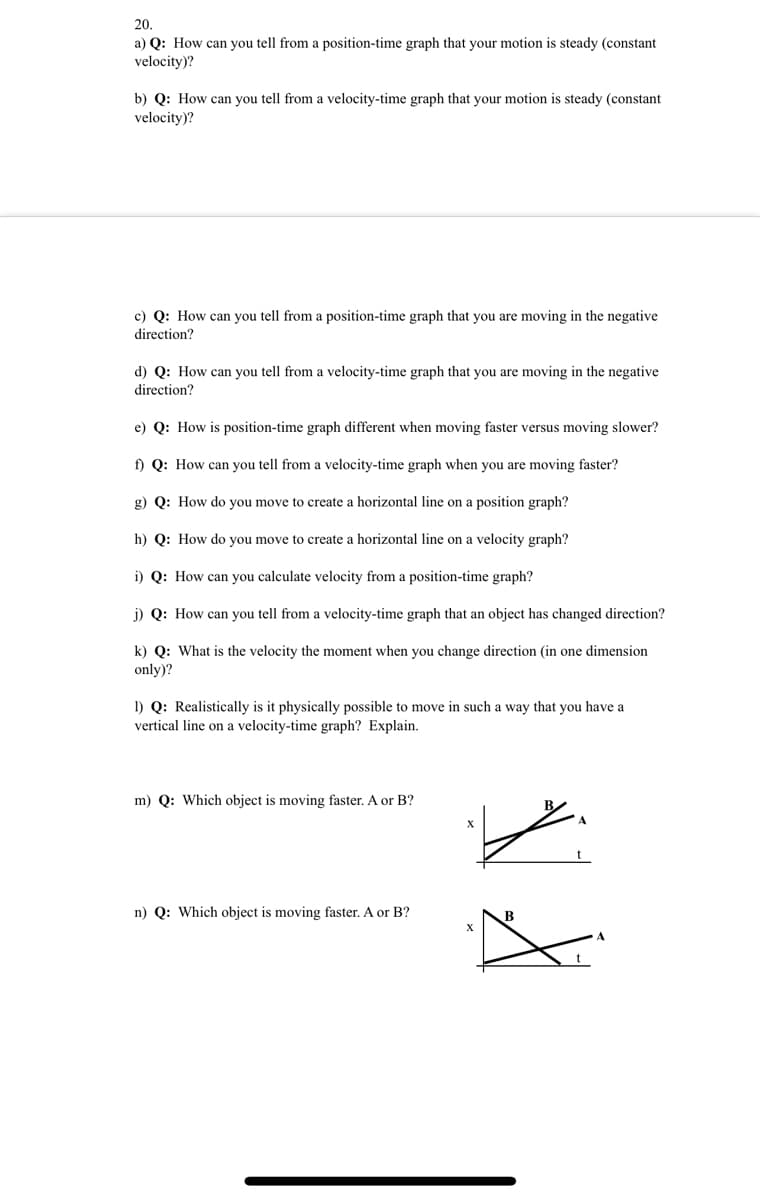20. a) Q: How can you tell from a position-time graph that your motion is steady (constant velocity)? b) Q: How can you tell from a velocity-time graph that your motion is steady (constant velocity)? c) Q: How can you tell from a position-time graph that you are moving in the negative direction? d) Q: How can you tell from a velocity-time graph that you are moving in the negative direction? e) Q: How is position-time graph different when moving faster versus moving slower? f) Q: How can you tell from a velocity-time graph when you are moving faster? g) Q: How do you move to create a horizontal line on a position graph? h) Q: How do you move to create a horizontal line on a velocity graph? i) Q: How can you calculate velocity from a position-time graph? j) Q: How can you tell from a velocity-time graph that an object has changed direction? k) Q: What is the velocity the moment when you change direction (in one dimension only)? I) Q: Realistically is it physically possible to move in such a way that you have a vertical line on a velocity-time graph? Explain. m) Q: Which object is moving faster. A or B? n) Q: Which object is moving faster. A or B?
20. a) Q: How can you tell from a position-time graph that your motion is steady (constant velocity)? b) Q: How can you tell from a velocity-time graph that your motion is steady (constant velocity)? c) Q: How can you tell from a position-time graph that you are moving in the negative direction? d) Q: How can you tell from a velocity-time graph that you are moving in the negative direction? e) Q: How is position-time graph different when moving faster versus moving slower? f) Q: How can you tell from a velocity-time graph when you are moving faster? g) Q: How do you move to create a horizontal line on a position graph? h) Q: How do you move to create a horizontal line on a velocity graph? i) Q: How can you calculate velocity from a position-time graph? j) Q: How can you tell from a velocity-time graph that an object has changed direction? k) Q: What is the velocity the moment when you change direction (in one dimension only)? I) Q: Realistically is it physically possible to move in such a way that you have a vertical line on a velocity-time graph? Explain. m) Q: Which object is moving faster. A or B? n) Q: Which object is moving faster. A or B?
Physics for Scientists and Engineers with Modern Physics
10th Edition
ISBN:9781337553292
Author:Raymond A. Serway, John W. Jewett
Publisher:Raymond A. Serway, John W. Jewett
Chapter2: Motion In One Dimension
Section: Chapter Questions
Problem 32P: A student drives a moped along a straight road as described by the velocitytime graph in Figure...
Related questions
Question
These are general questions for physics, please help answer them objectively thank you!

Transcribed Image Text:20.
a) Q: How can you tell from a position-time graph that your motion is steady (constant
velocity)?
b) Q: How can you tell from a velocity-time graph that your motion is steady (constant
velocity)?
c) Q: How can you tell from a position-time graph that you are moving in the negative
direction?
d) Q: How can you tell from a velocity-time graph that you are moving in the negative
direction?
e) Q: How is position-time graph different when moving faster versus moving slower?
f) Q: How can you tell from a velocity-time graph when you are moving faster?
g) Q: How do you move to create a horizontal line on a position graph?
h) Q: How do you move to create a horizontal line on a velocity graph?
i) Q: How can you calculate velocity from a position-time graph?
j) Q: How can you tell from a velocity-time graph that an object has changed direction?
k) Q: What is the velocity the moment when you change direction (in one dimension
only)?
I) Q: Realistically is it physically possible to move in such a way that you have a
vertical line on a velocity-time graph? Explain.
m) Q: Which object is moving faster. A or B?
t
n) Q: Which object is moving faster. A or B?
Expert Solution
This question has been solved!
Explore an expertly crafted, step-by-step solution for a thorough understanding of key concepts.
This is a popular solution!
Trending now
This is a popular solution!
Step by step
Solved in 2 steps

Knowledge Booster
Learn more about
Need a deep-dive on the concept behind this application? Look no further. Learn more about this topic, physics and related others by exploring similar questions and additional content below.Recommended textbooks for you

Physics for Scientists and Engineers with Modern …
Physics
ISBN:
9781337553292
Author:
Raymond A. Serway, John W. Jewett
Publisher:
Cengage Learning

Physics for Scientists and Engineers
Physics
ISBN:
9781337553278
Author:
Raymond A. Serway, John W. Jewett
Publisher:
Cengage Learning

Physics for Scientists and Engineers: Foundations…
Physics
ISBN:
9781133939146
Author:
Katz, Debora M.
Publisher:
Cengage Learning

Physics for Scientists and Engineers with Modern …
Physics
ISBN:
9781337553292
Author:
Raymond A. Serway, John W. Jewett
Publisher:
Cengage Learning

Physics for Scientists and Engineers
Physics
ISBN:
9781337553278
Author:
Raymond A. Serway, John W. Jewett
Publisher:
Cengage Learning

Physics for Scientists and Engineers: Foundations…
Physics
ISBN:
9781133939146
Author:
Katz, Debora M.
Publisher:
Cengage Learning

College Physics
Physics
ISBN:
9781285737027
Author:
Raymond A. Serway, Chris Vuille
Publisher:
Cengage Learning

College Physics
Physics
ISBN:
9781305952300
Author:
Raymond A. Serway, Chris Vuille
Publisher:
Cengage Learning

Principles of Physics: A Calculus-Based Text
Physics
ISBN:
9781133104261
Author:
Raymond A. Serway, John W. Jewett
Publisher:
Cengage Learning